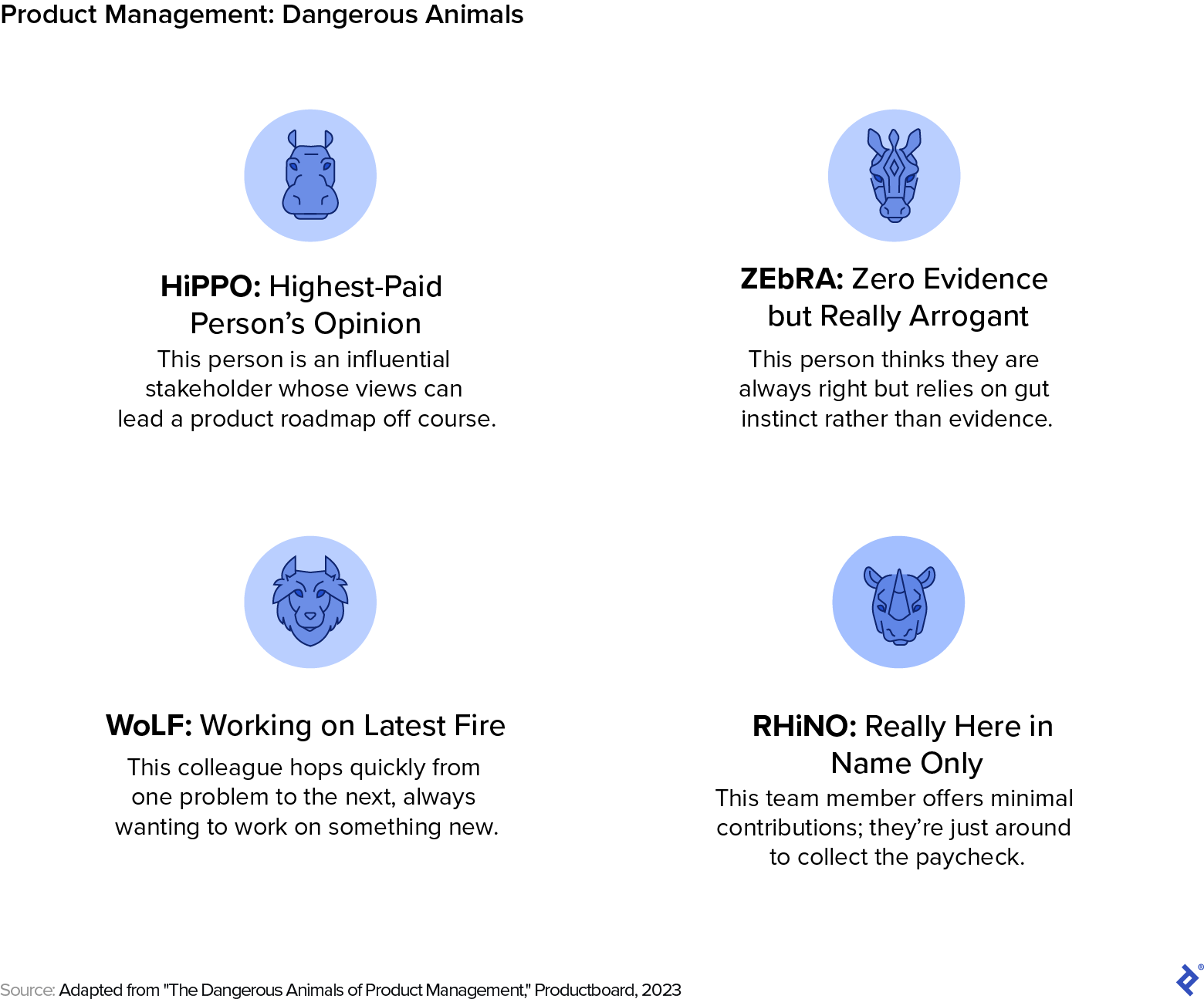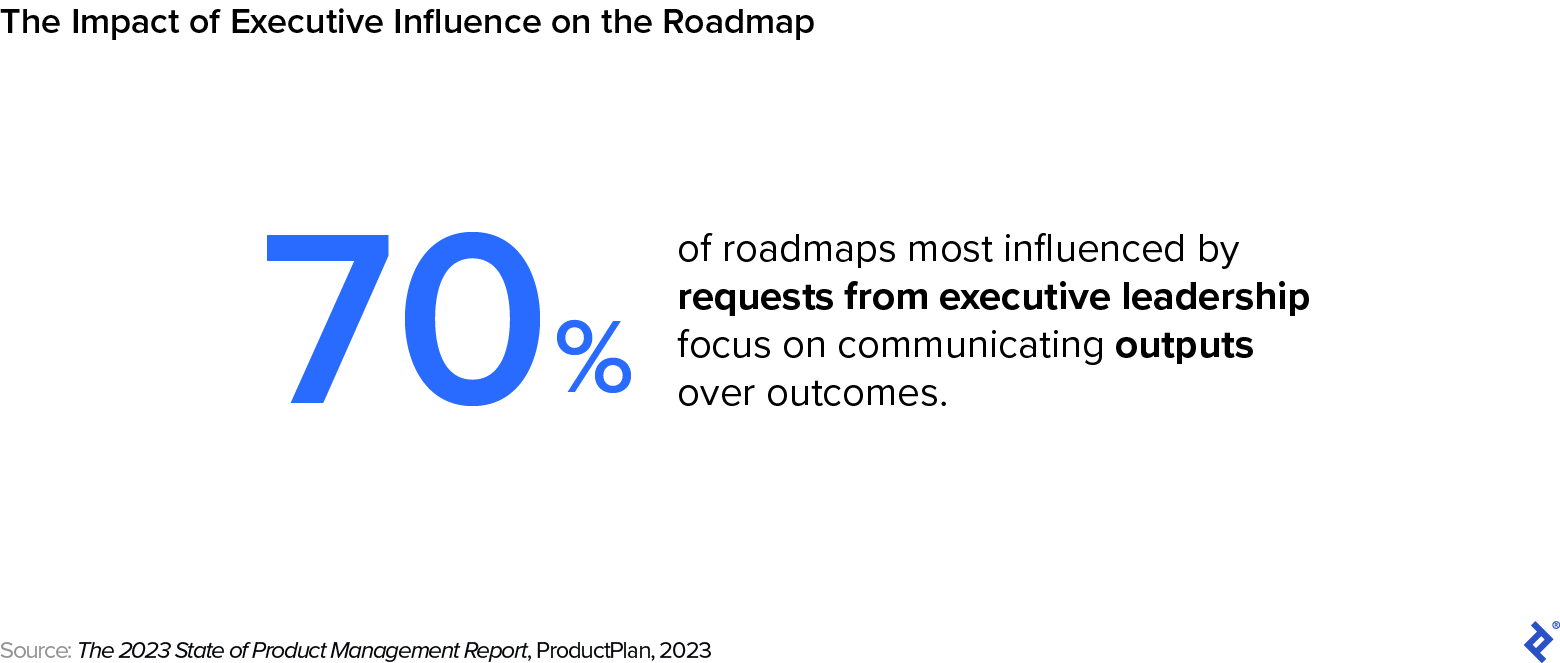HiPPOs and the Product Roadmap: How to Manage Senior Stakeholder Intervention
Don’t let someone’s intuition overshadow data-driven decision-making. Use these strategies to manage the highest-paid person’s opinions (HiPPO) and build robust, consistent processes around your product roadmap.
Don’t let someone’s intuition overshadow data-driven decision-making. Use these strategies to manage the highest-paid person’s opinions (HiPPO) and build robust, consistent processes around your product roadmap.
Ryan is a senior product manager and startup CEO with more than a decade of experience building innovative products. His previous roles include Director of Product Management at 7-Eleven, where he played a key role in creating the first cashierless store, and Product Manager at AIG Retirement. Ryan has led both software and hardware projects using data to guide and validate at every stage of the process.
Previous Role
VP of Product ManagementPREVIOUSLY AT

You’re presenting a well-crafted product roadmap to a room of stakeholders and team members when a senior leader starts to take over the meeting. This person is asserting their own judgments, suggesting alterations, and generally shifting focus away from your plan. While these actions may come from a place of good intentions and previous experience, the effect can be demoralizing. If not handled appropriately, this scenario can also have negative consequences on the product roadmap.
If you’ve been a product manager for any length of time, you’ve likely found yourself in this situation, face-to-face with the HiPPO: the “highest-paid person’s opinion.” The opinions of a high-ranking or influential person in the organization—who is often the person in a meeting with the highest salary—tend to take precedence over the insights of other team members. With such authority, the HiPPO can have a significant impact on the direction of the product roadmap; thus, going up against, or even disagreeing with, the HiPPO can be extremely intimidating.
I’ve been building products for more than a decade and I still regularly encounter the HiPPO. Over that time, however, I have developed strategies to enact before any product roadmap presentation to ensure stakeholder satisfaction and the best roadmap possible.

Why HiPPOs Are Dangerous
In a product development context, the HiPPO’s impact can be dangerous when they impose changes based on personal experience, intuition, or without full knowledge of the product or the range of factors that could affect its success. Additionally, these changes may not be in line with customer needs or market trends, resulting in products that are outdated, irrelevant, or fail to meet customer expectations.
Another problem arises when the HiPPO is risk averse, preferring the relative safety of tactics they have seen work well in the past. This can lead to a lack of innovation or a stagnant product roadmap. It can also lead to wasting time and resources on projects that end up failing, being axed, or getting redirected down the line.
Sometimes, executive input can result in roadmaps that have less room for creativity and experimentation. Agile product roadmaps should communicate outcomes rather than the outputs that Waterfall roadmaps typically do, but the 2023 State of Product Management Report found that 70% of roadmaps most influenced by requests from executive leadership focus on communicating outputs over outcomes.
Product roadmaps continually influenced by the HiPPO can stifle creativity and damage the morale of the product team. This is potentially the most detrimental impact of all, as a high-functioning team is vital to success.
Strategies to Manage the HiPPO
While HiPPOs pose many challenges, there are steps you can take to maintain control of your product and get buy-in from leadership.
Develop a High-quality, Evidence-based Roadmap
The first step is to ensure you have a product roadmap that works. This is a critical foundation for countering any opposing views, as you can have full confidence that your roadmap is the right way to go.
A strong product roadmap should include a clear vision and objectives, as well as a timeline for achieving them, with key milestones plotted. Identify the stakeholders involved at each stage of the process. Choose how you will measure success. Decide which metrics to track (e.g., customer satisfaction, engagement, revenue). Use this data to validate the quality of your future roadmaps.
For good product roadmap execution, identify how you will track progress, review and update the roadmap, and test and validate ideas. Quantitative data from surveys, combined with qualitative sentiment collection from interviews and other interactions, offers compelling insights that are hard to refute. Data from other sources, such as market research and competitor analysis, should be utilized too. You want to be able to respond to customer feedback and adapt to changing needs; you can do this by incorporating a feedback loop into the roadmap.
Establish a Decision-making Process
In order to maintain control of your product roadmap, create a robust process for decision-making. If you don’t have one already, develop a framework for gathering customer data and evaluating this information. This process and its results should be clearly documented and communicated to all stakeholders, including the senior figure. Refer back to this analysis to counter any opinions that don’t align with your evidence-based roadmap.
Put together a team with representatives from all relevant departments, including product management, engineering, marketing, and customer support. This team will have the authority to make collaborative decisions based on both data and subject matter expertise at certain points in the roadmap (although you should take steps to ensure that having this team in place doesn’t slow down your development process). Should the HiPPO intervene, this consistent evaluation will ensure the product stays on track.
Communicate Regularly With Stakeholders
Every stakeholder—including the senior figure—is important in creating a successful product, but it is crucial to ensure that there is a clear understanding of the product roadmap and each person’s role in it across all departments.
Establish one system for keeping stakeholders informed of changes to the roadmap, and another system for gathering, evaluating, responding to, and incorporating their feedback. When everyone feels heard, you will encounter fewer issues along the journey.
Foster Trust in the Product Team
Trust will be a vital component in building positive long-term relationships between the senior figure and the product team. Strengthen trust by celebrating evidence-based decisions from team members that produce successful results. A method that has worked well in my experience is a monthly or quarterly award given to an individual or group that tackled a problem having a detrimental impact on the product. This serves to demonstrate the value and expertise of the team, which will afford greater autonomy from senior figures in the future. It also emphasizes the importance of data-driven decision-making.
Set Clear Expectations
Finally, and perhaps most importantly, prior to any roadmap discussions, develop a system in partnership with the senior figure and your product team to manage their involvement in decision-making. You should allow all parties to feel heard while setting clear expectations for their roles and responsibilities. Everyone—including senior figures—should be held accountable for their decisions and input and be expected to provide evidence to support them. Be sure to document these processes formally and clearly for all team members. (This process may even deter the senior figure from offering unfounded opinions.)
Meet with the senior figure in a one-on-one setting a day or two before any large presentations, giving them a forum in which to express their concerns and you an opportunity to address these prior to the meeting. An intimate environment makes it easier to have more difficult discussions without the added pressure of an audience.
Product Roadmaps Are Driven by Data, Not Experience
The success of a product roadmap is dependent on being driven by data rather than personal experience or intuition. The HiPPO can, therefore, have a significant impact if their input is not handled well. Applying the simple but effective strategies I’ve laid out here can mitigate and prevent damage to the roadmap, product, and team. Having clear roles and boundaries in place, building trust, and making evidence-based decisions are critical.
Robust, consistent processes will help you and your team confidently design and execute product roadmaps that are in line with customer needs and market trends—and that will lead to profitable products. Feedback from senior figures can undoubtedly be valuable, but when it comes to the product and its roadmap, you and your team should have the insights that matter most.
Further Reading on the Toptal Blog:
Understanding the basics
What is the HiPPO problem in product management?
In product management, HiPPO stands for “highest-paid person’s opinion.” This is typically a senior figure with influence who asserts views based on previous experience rather than current data. This can be detrimental to, or even derail, the product roadmap.
Who is the audience for a product roadmap?
A product roadmap may be reviewed and contributed to by many different stakeholders, both internal and external. You should ensure each person understands the product roadmap and their contributing role.
What should a product roadmap include?
A good product roadmap should detail the vision, objectives, key milestones, success metrics, and relevant stakeholders for each stage of development.
Dallas, TX, United States
Member since January 11, 2022
About the author
Ryan is a senior product manager and startup CEO with more than a decade of experience building innovative products. His previous roles include Director of Product Management at 7-Eleven, where he played a key role in creating the first cashierless store, and Product Manager at AIG Retirement. Ryan has led both software and hardware projects using data to guide and validate at every stage of the process.
Previous Role
VP of Product ManagementPREVIOUSLY AT



